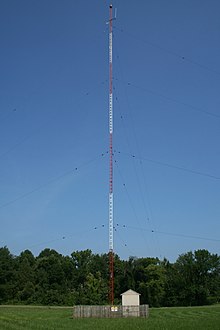
Back Antena monopol Catalan Monopolantenne Danish Groundplane-Antenne German Monopolo vertical Spanish آنتن تکقطبی Persian Maatasoantenni Finnish Antenne monopôle French אנטנת מונופול HE Antenna a monopolo Italian Marconi-antenne Dutch

A monopole antenna is a class of radio antenna consisting of a straight rod-shaped conductor, often mounted perpendicularly over some type of conductive surface, called a ground plane.[1][2][3] The driving signal from the transmitter is applied, or for receiving antennas the output signal to the receiver is taken, between the lower end of the monopole and the ground plane. One side of the antenna feedline is attached to the lower end of the monopole, and the other side is attached to the ground plane, which is often the Earth. This contrasts with a dipole antenna which consists of two identical rod conductors, with the signal from the transmitter applied between the two halves of the antenna.
The monopole is often used as a resonant antenna. The rod functions as an open resonator for radio waves and oscillates with standing waves of voltage and current along its length. The length of the antenna, therefore, is determined based on the wavelength of the desired radio waves. The most common form is the quarter-wave monopole, in which the antenna length is approximately one quarter of the wavelength of the radio waves. In broadcasting monopole antennas, however, lengths equal to 5/8 wavelength are also popular because in a monopole this length maximizes the power radiated perpendicular to the axis of the radiator, which with a vertical radiator optimizes efficiency for terrestrial broadcast. The monopole antenna was invented in 1895 by radio pioneer Guglielmo Marconi; for this reason it is sometimes called the Marconi antenna.[4][5][6]
The load impedance of the quarter-wave monopole is half that of the dipole antenna or 37.5 ohms.
Common types of monopole antenna are
- whip
- rubber ducky
- helical
- random wire
- umbrella
- inverted-L and T-antenna
- folded unipole and inverted-F
- mast radiator
- ground plane antennas
- ^ Poisel, Richard (2012). Antenna Systems and Electronic Warfare Applications. Artech House. p. 223. ISBN 9781608074846 – via Google Books.
- ^ Bevelacqua, Peter J. (2016). "The Monopole Antenna". Antenna Types. Antenna-Theory.com website. Retrieved 20 August 2020.
- ^ Straw, R. Dean; et al., eds. (2000). The ARRL Antenna Book (19th ed.). American Radio Relay League. p. 2.17. ISBN 9780872598041 – via Google Books.
- ^ Das, Sisir K. (2016). Antenna and Wave Propagation. Tata McGraw-Hill Education. p. 116. ISBN 978-1259006326 – via Google Books.
- ^ Wong, K. Daniel (2011). Fundamentals of Wireless Communication Engineering Technologies. John Wiley and Sons. p. 94. ISBN 978-1118121092 – via Google Books.
- ^ Kishore, Kamal (2009). Antenna and Wave Propagation. IK International Ltd. p. 93. ISBN 978-9380026060 – via Google Books.